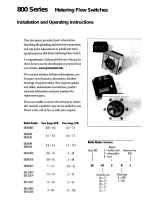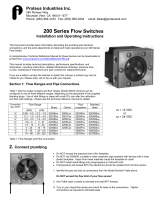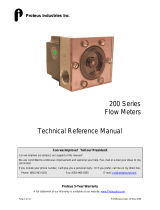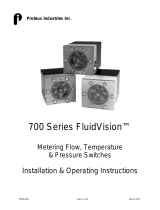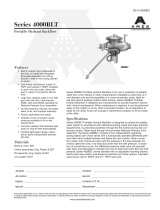Page is loading ...

SETUP GUIDE
V7000 Series
Vortex Flow Meters
This document describes the basic steps necessary to install and make operational
your V7000 Series vortex flow meter. Additional product information is available on
the Proteus Industries website at www.proteusind.com/v7000.
Flow Ranges, Frequency Ranges, and Connection Sizes
Flow Range (LPM) 1.8–30 3.5–50 5.0–85 9.0–150
Flow Range (GPM) 0.48–7.9 0.92–13 1.3–22 2.4–40
Frequency Range (Hz) ~25–350 ~20–270 ~15–230 ~12–200
Connection Sizes 3/8” FNPT
1/2” FNPT
3/4-16 SAE
3/4” FNPT
1/2” MNPT
3/4” MNPT
1/2” FNPT
3/4” FNPT
3/4” MNPT
1
1
⁄16-12 SAE
1” MNPT
3/4” FNPT
1” FNPT
1” MNPT
1” FNPT
1” MNPT
1¼” MNPT
1
5
⁄16-12 SAE
Inner Diameter 12 mm / 0.47 in 16 mm / 0.63 in 20 mm / 0.79 in 26 mm / 1.02 in
Flow Meter Specifications
Output Type Pulse Current Voltage
Output Square wave
1
4–20 mA 0–10 VDC
Fluid Temperatures -40–125 °C / -40–257 °F
Ambient Temperature -15–85 °C / 5.0–185 °F
Operating Pressure
Limit
2
1200 kPa at 40 °C / 174 psi at 104 °F
600 kPa at 100 °C / 87 psi at 212 °F
Input Voltage 4.75–33 VDC 8–33 VDC 11.5–33 VDC
1
The amplitude of the pulse frequency output is equal to the input voltage ± 5%.
2
Unrated. Please see CAUTION statement in Plumbing Connections section.
Temperature Sensor Specifications
Output Type Pulse Current Voltage
Measurement Range -40–125 °C / -40–257 °F -25–125 °C /-13–257 °F
Output Resistance (DIN EN 60751 Class B) 0–10 VDC
Pressure Sensor Specifications
Output Type Voltage
Measurement Range 0–1200 kPa / 0–174 psi
Output 0–8.7 VDC
Input Voltage 12–33 VDC

1. Plumbing Connections
V7000 Series flow meters can be installed into either horizontal or vertical piping,
as long as the instrument is properly oriented in the direction of the liquid flow. In
vertical installations, an upward flow direction is recommended.
NOTE
The instrument should be installed so that the arrows on the sides of
the body are facing in the direction of the liquid flow.
The flow response of a V7000 Series flow meter, and thus its calibration, may be
affected by the inner diameter (ID) of the incoming pipe as well as any devices
attached to the inlet connection and any nearby upstream devices.
NOTE
The inner diameter (ID) of the inlet piping or the through-hole of a tube
connector, hose barb, or other connecting element must be greater than
or equal to the ID of the flow meter.
Refer to the table below to identify the minimum ID of the connecting elements
for your instrument.
FLOW RANGE
MINIMUM ID OF
INLET CONNECTION
MINIMUM STRAIGHT RUN OF PIPE
LPM GPM INLET OUTLET
1.8–30 0.48–7.9 12 mm / 0.47 in 60 mm / 2.36 in 12 mm / 0.47 in
3.5–50 0.92–13 16 mm / 0.63 in 80 mm / 3.15 in 16 mm / 0.63 in
5.0–85 1.3–22 20 mm / 0.79 in 100 mm / 3.94 in 20 mm / 0.79 in
9.0–150 2.4–40 26 mm / 1.02 in 130 mm / 5.12 in 26 mm / 1.02 in
V7000 Series instruments can be used with right-angle elbows with a through-
hole ID greater than or equal to the ID of the flow meter.
NOTE
For assistance with applications involving elbows, please contact
Proteus Technical Support at [email protected] or (650) 964-4163.
To ensure optimum performance, straight runs of pipe should be present both
upstream and downstream from the instrument. Refer to the table above to
identify the minimum straight-pipe lengths required for your instrument.
a. Identify the plumbing connection size and ID of your V7000 Series instrument.
b. Make connections to pipe or other fittings as required. With threaded fittings,
it is recommended that you use a non-hardening pipe sealant, such as Teflon
®
(PTFE) tape or paste, to create leak-tight and lubricated junctions.
c. Turn on the liquid flow slowly and check for leaks at the connections. Tighten
connections as required to eliminate any leaks.
CAUTION!
» DO NOT exceed the maximum flow, temperature or pressure limits of
your instrument.
» Fast-closing valves can create high-pressure spikes (water
hammer), which can damage the vortex sensor.
» Damage may occur if liquid freezes inside the flow meter body.

2. Electrical Connections
a. Locate the DC power source and turn it OFF.
b. Make all wiring connections for your V7000 Series instrument as shown in the
tables below.
Flow Measurement Only
PIN WIRE PULSE OUTPUT CURRENT OUTPUT VOLTAGE OUTPUT
1 Brown Power supply Power supply Power supply
2 White No connection No connection No connection
3 Blue Pulse output (flow) No connection Voltage output (flow)
4 Black Supply return Current output* (flow) Supply return
5 Gray No connection No connection No connection
* The current return should be connected to the negative terminal of the power supply.
Flow and Temperature Measurement
PIN WIRE PULSE OUTPUT CURRENT OUTPUT VOLTAGE OUTPUT
1 Brown Power supply Power supply Power supply
2 White Resist. output 1 (temp.) Resist. output 1 (temp.) Voltage output (temp.)
3 Blue Pulse output (flow) No connection Voltage output (flow)
4 Black Supply return Current output* (flow) Supply return
5 Gray Resist. output 2 (temp.) Resist. output 2 (temp.) No connection
* The current return should be connected to the negative terminal of the power supply.
Pressure Sensor
PIN WIRE FUNCTION
1 Brown Power supply
2 White No connection
3 Blue Voltage output (press.)
4 Black Supply return
5 Gray No connection
c. Confirm that all wire connections are secure.
d. Turn the DC power source ON.

3. Flow Measurement
V7000 Series flow meters provide a pulse, current, or voltage output signal that
is directly proportional to the flow rate of the liquid passing through the device.
Typical characteristic lines for standard products with water calibration are
shown in the table below. Refer to the calibration sheet provided with your device
for unit-specific flow response information.
NOTE
Q = Volumetric flow rate (LPM)
ƒ
OUT
= Frequency output (Hz)
I
OUT
= Current output (mA)
V
OUT
= Voltage output (VDC)
FLOW RANGE PULSE OUTPUT CURRENT OUTPUT VOLTAGE OUTPUT
1.8–30 LPM Q = (0.0841 × ƒ
OUT
) - 0.2 Q = 2.000 × (I
OUT
- 4 mA) Q = 3.2 × V
OUT
3.5–50 LPM Q = (0.1861 × ƒ
OUT
) - 0.2 Q = 3.125 × (I
OUT
- 4 mA) Q = 5.0 × V
OUT
5.0–85 LPM Q = (0.3751 × ƒ
OUT
) - 0.3 Q = 5.313 × (I
OUT
- 4 mA) Q = 8.5 × V
OUT
9.0–150 LPM Q = (0.7370 × ƒ
OUT
) - 0.2 Q = 9.375 × (I
OUT
- 4 mA) Q = 15.0 × V
OUT
4. Temperature Measurement
Resistance Output
V7000 Series products with temperature measurement capability are equipped
with a Pt1000 resistance temperature detector (RTD) that conforms to the DIN EN
60751 Class B specification.
Resistance-output models have measurement range of -40–125 °C / -40–257 °F
and a nominal resistance of 1000 Ω at 0 °C / 32 °F.
Voltage Output
For voltage-output models, the measured liquid temperature (T) can be calculated
from the temperature sensor output using the equations below.
°C T = (V
OUT
× 15) - 25 °F T = (V
OUT
× 27) - 13
Voltage-output models have a measurement range of -25–125 °C / -13–257 °F.
5. Pressure Measurement
V7000 Series products with pressure measurement capability are equipped with
a ceramic piezoelectric sensor element. The measured liquid pressure (P) can be
calculated from the pressure sensor output using the equations below.
kPa P = V
OUT
× 137.9 psi P = V
OUT
× 20
The pressure sensor has a measurement range of 0–1200 kPa / 0–174 psi.
Information in this document was correct at the time of
printing; however, specifications are subject to change as
Proteus Industries’ continuous improvement processes
establish new capabilities.
© Proteus Industries Inc. All rights reserved. All other
company and product names may be trademarks of their
respective companies.
V7000SG Rev 005 02/2017
/

